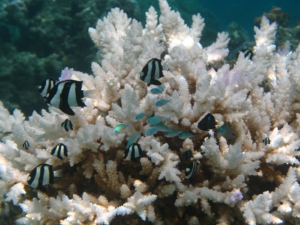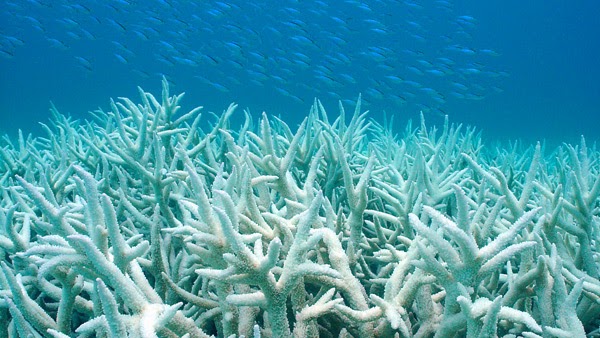Coral Bleaching
In our previous post we discussed that corals live in mutualism with phytoplankton. Mutualism is a type of relationship where both partners benefit from the interaction. Phytoplankton are single-celled plants that can be found in all bodies of water. This relationship between the corals and phytoplankton is at the basis of corals bleaching.
Healthy corals come in all shades of brown and some species of corals are stunningly vibrant and colourful. Unhealthy, bleached, corals are white.

Credit: ACR center of excellence for coral reef studies (flickr)
Corals, polyp colonies, are filter feeders. This means they rely on the flow of water to bring food to them. Small particles of food floating in the water column land on their sticky tentacles and can be put in their mouths. The coral species that live in a mutualistic relationship with phytoplankton rely on the plants for food. The single-celled plants live in the coral’s tissues where they are safe from the harsh environment of the open water. There are a few types of phytoplankton who live within coral tissues and they are collectively called zooxanthellae.
Zooxanthellae can photosynthesize. If we all take a moment to think back to high school biology classes we should recall that plants use sunlight to turn water and carbon dioxide into glucose. The same goes for zooxanthellae. Mutualistic corals live in shallow waters where the light still penetrates, this is so that their buddies can photosynthesize. The glucose produced by zooxanthellae is food for the corals. So corals and zooxanthellae trade safety for food.
Coral bleaching is the process of corals expelling the zooxanthellae from their tissues. Corals can survive for a few days to a few weeks without zooxanthellae. When the average daily temperatures of the water rises by 1 degree celsius for a few days or more, corals start the bleaching process. They do this because they are stressed by the heat. If the elevated temperatures last for several weeks, as is happening in many places across the tropics, corals die. More than two thirds of corals can die on a single reef due to coral bleaching in a single season.
To know more how this is impacting our oceans stay tuned for our next blog: Corals Are Keystone Species.
Some Links
Rising Ocean Temperatures are “Cooking” Coral Reefs | National Geographic
Author:
Layla Olefs
Sustainability Manager and Co-Founder of White Green Blue.
Layla is on a mission to create positive impact and to spread awareness about our beautiful home. As a marine conservationist and PADI Dive Master her passion is the marine world and, of course, mangroves. She is the author of our Ecology and Culture blog series. Stephen Olefs, our Community Development Coordinator, is taking the lead in our Green Tech blog series.









